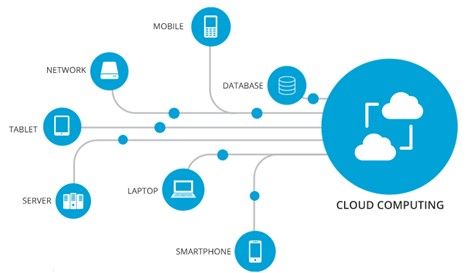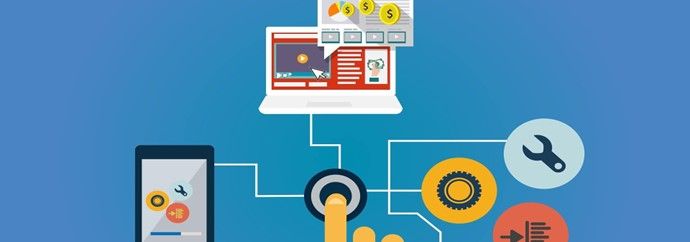Cloud Computing
Cloud computing means that we can access the applications as utilities, over the Internet. It allows us to create, configure, and customize applications online.
With cloud computing users can access database resources via the internet from anywhere for as long as they need without worrying about any maintenance or management of actual resources.
- Developers of new Internet services no longer require large capital outlays in hardware to deploy their service or the human expense to operate it thus avoiding both over-provisioning and under-provisioning.
- Cloud Computing refers to both the apps delivered as services over the Internet and the hardware and system software in the data center that provide those services. The services themselves are referred to as Software-as-a-Service (SaaS). The data center hardware and system software are what we will call a Cloud.
- A cloud that is available in a pay-as-you-go model to the general public is Public Cloud; the service being sold is Utility Computing.
- Private Cloud refers to internal data centers of a business or other organization not made available to the general public.
- Cloud Computing is the sum of SaaS and Utility Computing.
History of Cloud Computing
Before emerging the cloud computing, there was Client/Server computing which is basically centralized storage in which all the software applications, all the data and all the controls have resided on the server-side. Let’s have a quick walkthrough of cloud computing history and evolution all these years.

- 1960’s - One of the renowned names in Computer Science, John McCarthy, enabled enterprises to use expensive mainframes and introduced the whole concept of time-sharing. This turned out to be a huge contribution to the pioneering of the Cloud computing concept and the establishment of the Internet.
- 1969 - With the vision to interconnect the global space, J.C.R. Lickliter introduced the concepts of “Galactic Network” and “Intergalactic Computer Network” and also developed Advanced Research Projects Agency Network- ARPANET.
- 1970 - By this era, it was possible to run multiple Operating Systems in an isolated environment.
- 1997 - Prof. Ramnath Chalupa introduced the concept of “Cloud Computing” in Dallas.
- 1999 - Salesforce.com started the whole concept of enterprise applications through the medium of simple websites. Along with that, the services firm also covered the way to help experts deliver applications via the Internet.
- 2003 - The Virtual Machine Monitor (VMM), allows running multiple virtual guest operating systems on a single device, paving the way ahead for other huge inventions.
- 2006 - Amazon also started expanding in cloud services. From EC2 to Simple Storage Service S3, they introduced the pay-as-you-go model, which has become a standard practice even today.
- 2013 - With IaaS, (Infrastructure-as-a-Service), the Worldwide Public Cloud Services Market totaled £78bn, which turned out to be the fastest-growing market service of that year.
What is Cloud?
- The term Cloud refers to a Network or Internet. In other words, we can say that cloud is something, which is present in a remote location.
- Cloud can provide services over networks... WAN, LAN, or VPN.
- Applications such as e-mail, web conferencing, and customer relationship management (CRM), all run in the cloud.
What is Cloud Computing?
Cloud Computing refers to manipulating, configuring, and accessing the application online. It offers online data storage, infrastructure, and application. Cloud Computing is both a combination of software and hardware-based computing resources delivered as a network service.
How does cloud computing work?
Cloud computing works by enabling client devices’ data and cloud applications over the internet from remote physical servers, databases, and computers. network, and cloud software applications, with the back end, which consists of databases, servers, and computers. The backend functions as a repository, storing data that is accessed by the front end. Communications between the front and back ends are managed by a central server. The central server relies on protocols to facilitate the exchange of data. The central server uses both software and middleware to manage the connectivity between different client devices and cloud servers. Typically, there is a dedicated server for each application or workload.
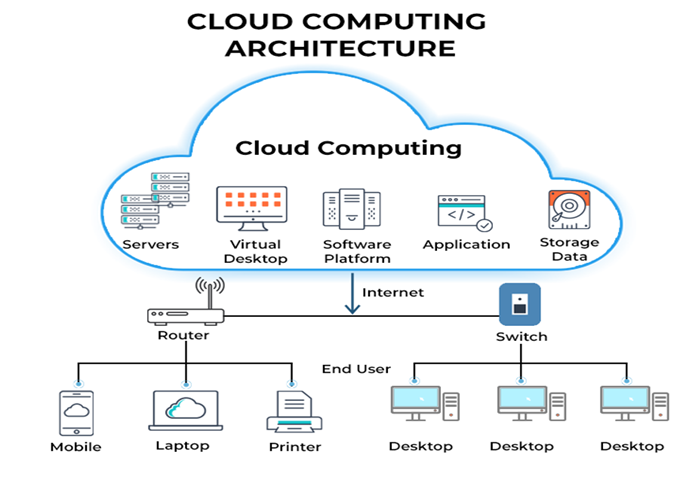
While the concept technically launched in the mid-1990s, cloud computing became mainstream beginning in the mid-2000s, with the emergence of the “big 3”: Google Cloud Platform, Microsoft Azure, and Amazon Web Services (AWS).
Types of cloud computing services
- Public Clouds are owned and operated by third-party cloud service providers, which deliver their computing resources like services and storage over the Internet. Microsoft Azure is an example of a public cloud. With a public cloud, all hardware and other supporting infrastructure are owned and managed by the cloud provider. You access these services and manage your account using a web browser
- Private cloud refers to cloud computing resources used exclusively by a single business organization. A private cloud can be physically located in the company’s on-site data center. Some companies also pay third-party service providers to host their private cloud. A private cloud is one in which the services and infrastructure are maintained on a private network.
- **hybrid cloud **combines private clouds, bound together by technology that allows data and applications to be shared between them, by allowing data and applications to move between private and public data clouds, a hybrid cloud gives your business greater flexibility, more deployment options, and optimize your existing infrastructure, security and compliance.
What cloud-computing services are available?
Cloud-computing services cover a vast range of options now, from the basics of storage, networking, and processing power, to natural language processing and artificial intelligence as well as standard office applications. Any service that doesn't require you to be physically close to the computer hardware you are using can now be delivered via the cloud – even quantum computing.
Why is it called cloud computing?
A fundamental concept behind cloud computing is that the location of the service, and many of the details such as the hardware or operating system on which it is running, are largely irrelevant to the user. It's with this in mind that the metaphor of the cloud was borrowed from old telecoms network schematics, in which the public telephone network (and later the internet) was often represented as a cloud to denote that the location didn't matter – it was just a cloud of stuff. This is an over-simplification of course; for many customers, the location of their services and data remains a key issue. Cloud computing as a term has been around since the early 2000s, but the concept of computing as a service has been around for much, much longer – as far back as the 1960s, when computer bureaus would allow companies to rent time on a mainframe, rather than have to buy one themselves.
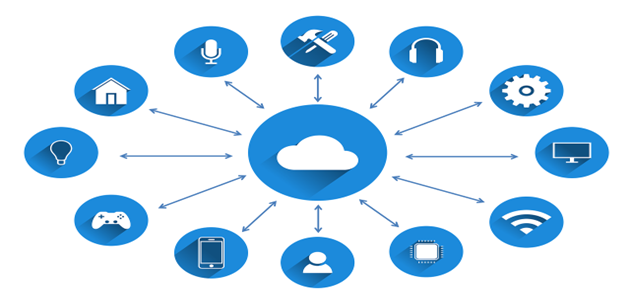
What are the benefits of cloud computing?
The exact benefits will vary according to the type of cloud service being used but, fundamentally, using cloud services means companies not having to buy or maintain their computing infrastructure.
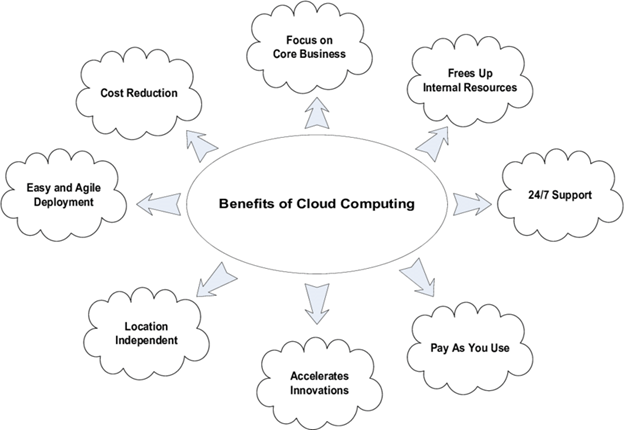
business advantages of cloud computing. • Cost Savings • Security • Flexibility • Mobility • Insight • Increased Collaboration • Quality Control • Disaster Recovery • Loss Prevention • Automatic Software Updates • Competitive Edge • Sustainability
No more buying servers, updating applications or operating systems, or decommissioning and disposing of hardware or software when it is out of date, as it is all taken care of by the supplier. For commodity applications, such as email, it can make sense to switch to a cloud provider, rather than rely on in-house skills. A company that specializes in running and securing these services is likely to have better skills and more experienced staff than a small business could afford to hire, so cloud services may be able to deliver a more secure and efficient service to end-users. 94% of Businesses claimed saw an improvement in security after switching to the cloud. 91% said the cloud makes it easier to meet government compliance requirements. Cloud computing operates on a similar principle as web-based email clients, allowing users to access all of the features and files of the system without having to keep the bulk of that system on their computers. Most people already use a variety of cloud computing services without even realizing it. Gmail, Google Drive, TurboTax, and even Facebook and Instagram are all cloud-based applications. For all of these services, users are sending their data to a cloud-hosted server that stores the information for later access.
And as useful as these applications are for personal use, they're even more valuable for businesses that need to be able to access large amounts of data over a secure, online network connection. For example, employees can access customer information via cloud-based CRM software like Salesforce from their smartphone or tablet at home or while traveling, and can quickly share that information with other authorized parties anywhere in the world.
Disaster Recovery
- While 20% of cloud users claim disaster recovery in four hours or less, only 9% of non-cloud users could claim the same.
- In a recent survey, 43% of IT executives said they plan to invest in or improve cloud-based disaster recovery solutions.
Using cloud services means companies can move faster on projects and test out concepts without lengthy procurement and big upfront costs because firms only pay for the resources they consume. This concept of business agility is often mentioned by cloud advocates as a key benefit. The ability to spin up new services without the time and effort associated with traditional IT procurement should mean that it is easier to get going with new applications faster. And if a new application turns out to be wildly popular, the elastic nature of the cloud means it is easier to scale it up fast. For a company with an application that has big peaks in usage, such as one that is only used at a particular time of the week or year, it might make financial sense to have it hosted in the cloud, rather than have dedicated hardware and software laying idle for much of the time. Moving to a cloud-hosted application for services like email or CRM could remove a burden on internal IT staff, and if such applications don't generate much competitive advantage, there will be little another impact. Moving to a services model also moves spending from capital expenditure (CAPEX) to operational expenditure (OPEX), which may be useful for some companies.
What is cloud-computing adoption doing to IT budgets
Cloud computing tends to shift spending from CAPEX to OPEX, as companies buy computing as a service rather than in the form of physical servers. This may allow companies to avoid large increases in IT spending which would traditionally be seen with new projects; using the cloud to make room in the budget might be easier than going to the CFO and looking for more money. Of course, this doesn't mean that cloud computing is always or necessarily cheaper than keeping applications in-house; for applications with a predictable and stable demand for computing power, it might be cheaper (from a processing power point of view at least) to keep them in-house.
Cloud computing budgets will hit 51% of IT spending by 2025 and will continue to increase beyond that. It’s time to change how we think about the cloud. Recent research shows that 51% of IT budgets will go to cloud-based systems development and operations by 2025. No surprises there; we all know this day is coming. We also know that the cloud budget percentage will continue to increase long after 2025. Is it time to change how we think about cloud computing? Enterprise IT spending on public cloud computing will overtake spending on traditional IT in 2025, within addressable segments, according to Gartner. The research includes only those enterprise IT categories that can transition to the cloud: application software, infrastructure software, business process services, and system infrastructure markets. Gartner found that by 2025, 51% of IT spending in these four categories will have shifted from traditional solutions to public clouds. This is compared to 41% in 2022.
Conclusion
To conclude, Cloud computing is the latest technology that promises immense benefit however there is a lot of research is still required in this area as many of the concerns related to security and privacy issues are not been answered by the experts and remains open. However, there is a lot of research and investment in the area by the Information technology giants like Microsoft, Google, Cisco, and IBM in this area and the day is not far when the cloud will widespread adopted and all the security and privacy issues will be handled. This report discussed the various types of cloud service models and the risk associated with each of them. Apart from it, the famous DDOS attack of 2013 was also discussed and the weakness of the application layer is leading to attacks. I would like to say that I look forward to these types of discussions where I get a platform to gain more from the knowledge and experiences of people around me. It is expected that the use of cloud computing would increase in the coming team.
